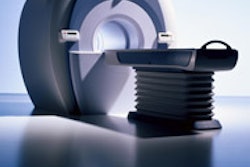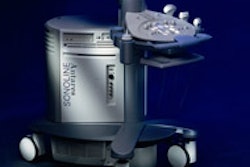CHICAGO - In acute stroke patients, the decision to give thrombolytic therapy is a crudely calculated risk: Will tPA salvage infarcted but still-living tissue -- or merely heighten the patient's risk of bleeding? Knowing how much time has elapsed since the infarct began is useful in a statistical sense -- sooner is always better -- but the method offers little information about the individual patient's chances.
Researchers at Massachusetts General Hospital in Boston are hoping to demystify this leap of faith based on a technique that helps gauge the status of the individual infarct when therapy is being considered. At Friday's stroke imaging session of the RSNA meeting, Dr. William Copen, who is also with Harvard Medical School, discussed a study that looked for differences in core apparent diffusion coefficients in ischemic stroke patients.
Diffusion-weighted MRI can not only detect acute ischemic stroke with high sensitivity, but previous research has suggested that it may also be able to assess the stage of tissue damage by measuring the apparent diffusion coefficient (ADC) of water in dead brain tissue, Copen said.
"ADC demonstrates a stereotypical sequence of changes during the evolution of the infarct," he said. "These changes have been correlated microscopically with progressive stages of tissue damage."
Following stroke onset, relative ADC, or ADC expressed as a fraction of its normal value (rADC), declines rapidly from its initial value of 1 during the first few hours, before rising again to remain permanently elevated, he explained. Previous research has demonstrated that the pace of these changes varies depending on etiology and patient age.
Variance on size and tissue type?
"For this study we sought to determine whether size and tissue type, meaning gray versus white matter, also may affect the pace of ADC changes," Copen said. "These differences could reflect the rates of tissue damage, and could apply different therapeutic windows for thrombolytic or neuroprotective therapy."
From 3,180 patients over 21 months, the researchers examined 235 lesions corresponding to a neurological deficit whose time of onset could be ascertained to within a 5% margin of error. Using a 3 x 3-mm region of interest in the middle slice of each lesion, they measured ADC at the core of the infarct divided by presumably normal ADC on the contralateral side of the brain, to yield rADC.
The lesions were grouped as small (comprising less than five slices) or large (more than five slices), though Copen allowed that this could have resulted in the inclusion of unaffected tissue due to volume averaging errors, particularly in smaller lesions. Much higher ADC variance among smaller lesions suggested that this was a real issue, he said. To compensate for the problem, the group used a standard deviation of 2 points above the mean variance, and excluded seven scans that exceeded the standard deviation.
The results statistically predicted the time course of ADC for all lesion subgroups (small gray matter: 18.4 (3.29)h; large gray matter: 8.71 (3.29)h; small white matter: 19.3 (5.27)h; and large white matter: 56.8 (225)h lesions).
Both lesion size and tissue type affected the rate of ADC ascent (p < 0.001), particularly for large white matter lesions. However, the number of large white matter lesions was small, and owing to the imprecision of the parameter estimates, these lesions weren't included in final calculations of the time course of each subgroup.
The transition from decreasing to increasing rADC occurred significantly earlier in large lesions than in small ones (p = 0.15), Copen said. There was also a statistically significant interaction of lesion size and tissue type (p = 0.045), such that among large lesions only, transition was predicted to occur earlier in gray matter than in white matter lesions.
Main effects of both lesion size and tissue type were seen on the subsequent rate of chronic ascent of rADC, which occurred more rapidly in smaller lesions than in larger ones (p < 0.001), and more rapidly in gray matter than in white matter (p = 0.009).
"The heterogeneity that we've seen and previous studies on the rates of evolution suggest that the right way to decide whether to give tPA or another thrombolytic drug may not just be based on clinical history -- is this one hour after the infarct began, two hours, three hours? -- but also on some direct measurement of how advanced the infarct is," Copen told AuntMinnie.com after his presentation.
Also, infarct-based assessment is an important goal because even within the lesion subgroups there is significant variation. "What we're eventually working for is a method, probably based on MRI, that includes (DWI) as well as perfusion, T2 and other measures which will give the clinician a much more detailed sense of how advanced the infarct is, and what the potential risks and benefits are of doing thrombolysis at that time," he said.
For now, the study suggests that at a particular time point after stroke onset, clinicians might lean toward not giving thrombolytic therapy for larger infarcts, Copen said.
By Eric Barnes
AuntMinnie.com staff writer
December 3, 2004
Related Reading
Immediate CT scanning after stroke cost-effective, November 23, 2004
Beyond CT: Diagnosing the unusual stroke, October 20, 2004
Transient ischemic attacks induce tolerance to stroke, March 15, 2004
Ultrasound boosts efficacy of TPA for ischemic stroke, February 10, 2004
MRI alters course of thrombolytic treatment for stroke, March 25, 2003
Copyright © 2004, AuntMinnie.com



















